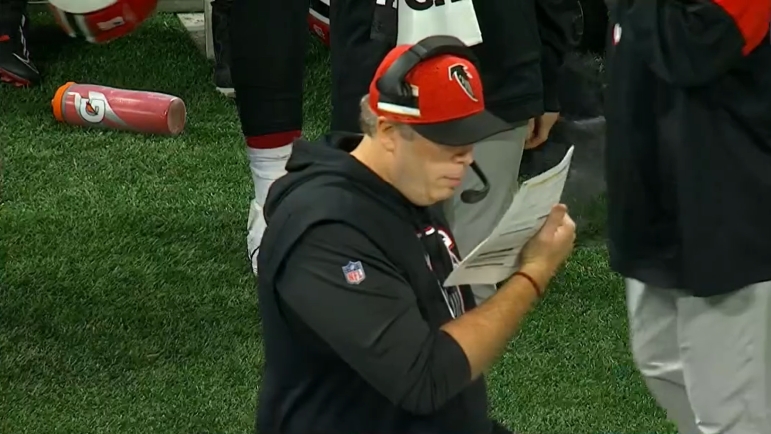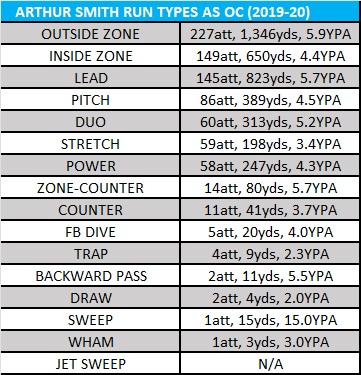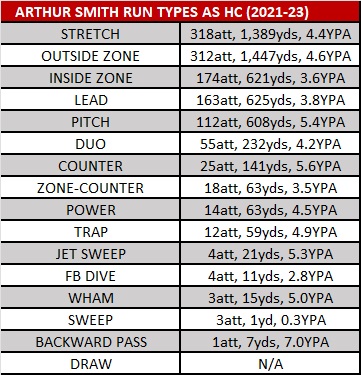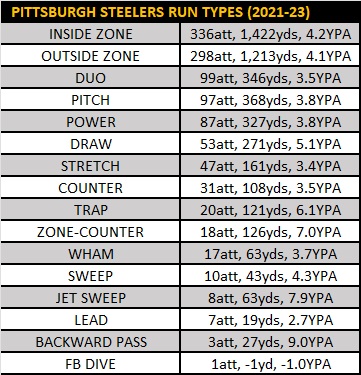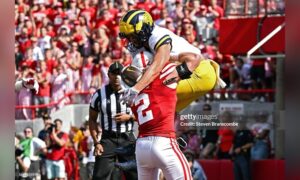I wanted to continue learning and providing data on new offensive coordinator Arthur Smith. Today’s goal is to look at his prior tendencies and success in the run game Atlanta, comparing that to his time as offensive coordinator in Tennessee along with Pittsburgh’s recent results, and see what that could mean for the Steelers in 2024.
First, here is a table from my first study – linked above – of Smith’s run types used in 2019-2020 with the Titans, sorted by most attempts:
This quick reminder shows outside zone runs were most utilized by far, and was highly successful from a yardage perspective, especially considering that volume. Being an “outside zone guy” has been a common talking point about what Pittsburgh should expect with the addition of Smith.
The first study also pointed to optimism on the addition, learning that outside zone was the second most utilized run type by Pittsburgh, at a respectable 4.2 YPA from primary RBs Najee Harris and Jaylen Warren.
Some other interesting/surprising findings were Harris fared best with 4.3 outside zone YPA, compared to Warren at 3.7 YPA, with the latter holding the better inside zone mark (4.2 YPA) on Harris (3.9 YPA).
Smith’s stellar 5.9 YPA number on outside zone as Tennessee’s OC will hopefully marry well with Harris’ stronger number over the last two years, and the team in general. Looking at individual seasons, the Titans were second and eighth in wide zone yards in the span (sixth and 17th in attempts).
Very impressive, and hopefully carries over to Pittsburgh. Check out the link at the top of the article if you want a deeper breakdown on Smith’s time in Tennessee.
Now, let’s look at and compare his three seasons as head coach for the Atlanta Falcons:
What jumps out right away is stretch runs were the most common run type by Smith in Atlanta, not outside zone. The tallies come in similar, with stretch at 318 attempts, and 312 outside zone attempts. Both featured healthy YPA, with 4.4 in stretch, and a 4.6 outside zone number.
From a YPA perspective, outside zone saw far more success in Tennessee (5.9 YPA versus 4.6 with Falcons), a substantial difference from Smith and RB Derrick Henry indeed. Despite the much higher usage, stretch was more successful with the Falcons by a whole yard per carry (4.4 YPA versus 3.4) which is very notable.
According to Sports Info Solution’s charting, Atlanta led the league in stretch attempts and yards in 2022 and 2023 and was the only team in the three-year span to eclipse 100 attempts in each (144, 123). Expectedly, they also led the league in yards both of those seasons (673, 542), and ranked 13th in 2021 with 194 yards on 51 attempts (tied for fifth-most).
This points to an encouraging willingness to lean on different concepts in each job, which will be interesting to watch play out in Pittsburgh.
Here are Smith’s run types with more YPA in Tennessee than Atlanta:
Outside Zone: TEN 5.9 YPA (227 attempts). ATL 4.6 YPA (312 attempts).
Inside Zone: TEN 4.4 YPA (149 attempts). ATL 3.6 YPA (174 attempts).
Lead: TEN 5.7 YPA (145 attempts). ATL 3.8 YPA (163 attempts).
Duo: TEN 5.2 YPA (60 attempts). ATL 4.2 YPA (55 attempts).
Zone-counter: TEN 5.7 YPA (14 attempts). ATL 3.5 YPA (18 attempts).
FB Dive: TEN 4.0 YPA (five attempts). ATL 2.8 YPA (four attempts).
Draw: TEN 2.0 YPA (two attempts). ATL N/A.
Sweep: TEN 15.0 YPA (one attempt). ATL 0.3 YPA (three attempts).
An important reminder that the sample sizes are different when considering the attempts (two years in Tennessee, three in Atlanta), but included them for context. Of the 16 included run types, exactly half of them (eight) saw better YPA in his time with the Titans.
After the aforementioned outside zone results, inside zone was better in Tennessee by nearly an entire yard (4.4 YPA). Lead was used more and was extremely successful with Tennessee, with that excellent 5.7 YPA on substantial attempts far exceeding his 3.8 number in Atlanta. Duo was also used more in Tennessee and featured a YPA differential of plus-one.
Then we see the less utilized schemes. Large difference in zone counter YPA and sweep. The latter was a 15-yard gain on the lone attempt for the Titans (15.0 YPA), while three opportunities for the Falcons landed on the other extreme of the spectrum (0.3 YPA).
Draw is very notable, with Smith avoiding it overall. Only two attempts in Tennessee (2.0 YPA), and incredibly none over three seasons with Atlanta, compared to it being Pittsburgh’s sixth most common of the span (53 attempts).
Runs with more YPA in Atlanta than Tennessee:
Stretch: ATL 4.4 YPA (318 attempts). TEN 3.4 YPA (59 attempts).
Pitch: ATL 5.4 YPA (112 attempts). TEN 4.5 YPA (86 attempts).
Counter: ATL 5.6 YPA (25 attempts). TEN 3.7 (11 attempts).
Power: ATL 4.5 YPA (14 attempts). TEN 4.3 YPA (58 attempts).
Trap: ATL 4.9 YPA (12 attempts). TEN 2.3 YPA (four attempts).
Jet Sweep: ATL 5.3 YPA (four attempts). TEN N/A.
Wham: ATL 5.0 YPA (three attempts). TEN 3.0 YPA (one attempt).
Backward Pass: ATL 7.0 YPA (one attempt). TEN 5.5 YPA (two attempts).
Stretch is obviously most notable, as previously mentioned. Pitch is the other encouraging result, given the substantial opportunities and YPA of nearly an entire yard.
The rest of the concepts are 25 attempts or less, pointing to less desirable results overall in Atlanta as expected. Several factors such as additional duties as a head coach and caliber of team could point to this, with the data giving added context. Counter was successful for Smith and the Falcons at 5.6 YPA on 25 attempts, compared to 3.7 in Tennessee (11 attempts).
The data on power runs jumps out, only 14 attempts in his three years in Atlanta (4.5 YPA), and many more attempts (58) in just two seasons with the Titans on a similar 4.3 YPA. Trap worked well for the Falcons and Smith (4.9 YPA, 12 attempts), while Tennessee used it less with poor results (2.3 YPA).
The rest were five attempts or less. No RB jet sweeps for the Titans with Smith but did it on four occasions in Atlanta with a healthy 5.3 YPA. Wham and backward pass were rarely used by Smith in either coaching spot as well.
For comparison, I wanted to include Pittsburgh’s team data for the last three seasons. It’s important to note that Warren wasn’t with the team in 2021, but wanted to get a matching sample size to Smith’s time as a head coach in Atlanta for this article:
Inside zone tops the list for Pittsburgh, with similar attempts all three seasons. This was in the top three run types for Smith across the study, so expect a high dosage to continue in 2024. Outside zone is second for Pittsburgh, with 101 attempts in 2021, increasing to 132 in 2022, then a notable dip to 65 last season. Harris and Smith’s success in that scheme are very encouraging, and hopefully marry well in 2024.
Up next in volume for the Steelers was duo (99 attempts) and pitch (97). Smith ran duo 55 times in Atlanta (sixth most common), and encouragingly had stronger YPA than Pittsburgh in both coaching spots. Pitch was commonly used across the board, with Smith’s units getting 4.5 YPA (TEN) and 5.4 in Atlanta, healthy numbers.
Noticeable differences in volume starts with power scheme. Pittsburgh ran it 87 times (fifth-most), compared to just 14 for the Falcons the last three seasons. 58 in Smith’s time in Tennessee (two years), and had strong YPA with both clubs, so it will be interesting to see what this looks like with the black and gold. 53 draws for Pittsburgh (5.1 YPA), and Smith avoiding it with just two attempts in all five seasons.
The biggest surprise was Smith’s top run type being stretch in Atlanta (318 attempts, 4.4 YPA), compared to just 47 attempts for the Steelers the last three years (3.4 YPA). Perhaps this will be a package that leans more to Warren, who averaged 4.3 YPA the last two years (albeit just 15 attempts), compared to Harris’ 3.3 YPA on 29 attempts. Worth monitoring, considering Smith ran stretch far less in Tennessee.
Pittsburgh’s following schemes were under 50 attempts: stretch, counter, trap, zone-counter, wham, sweep, jet sweep, lead, backward pass, and FB dive. Along with the stretch findings, lead is another concept that stands out. Smith leaned on the concept in both spots heavily, with 163 attempts in Atlanta (3.8 YPA), and 145 in Tennessee with a much better 5.7 YPA. In comparison, Pittsburgh has just seven attempts and a 2.7 YPA the last three years.
So, Smith indeed has tendencies that are well-documented, but showed a willingness to adjust scheme at each coaching spot, encouragingly. A commonality was his top six schemes regardless of coaching position/spot: stretch, outside zone, inside zone, lead, pitch, and duo. Outside zone, inside zone, pitch, and duo tendencies align similarly with Pittsburgh, while stretch and lead was utilized much more by Smith than the Steelers the last three seasons. Power and draws were in the top six most common run types for Pittsburgh the last three seasons, which could downtick given the findings on Smith the last five years.
Very excited to continue learning this offseason, with success rates, EPA, and more dives on Smith coming soon. Hopefully his addition aids a more consistent rushing attack for Pittsburgh in 2024.

